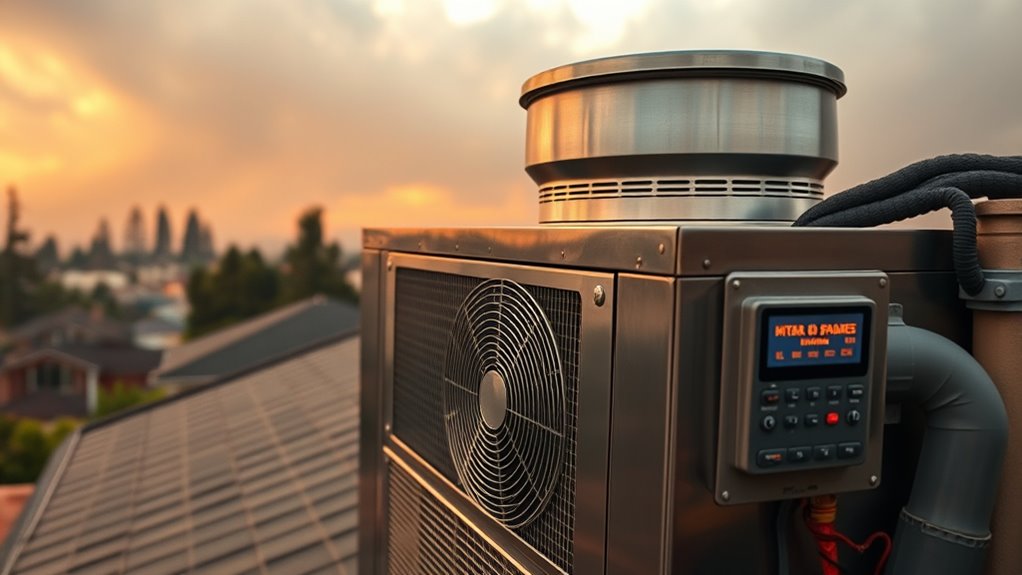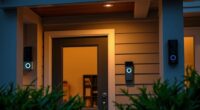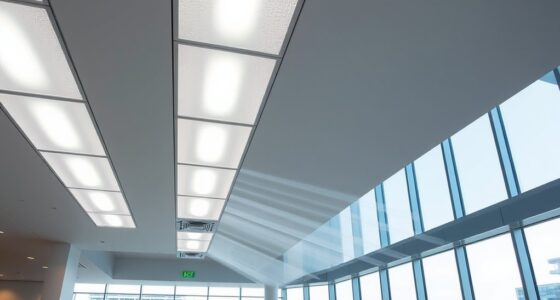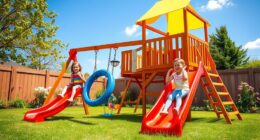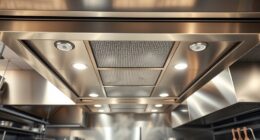To protect your home during wildfire smoke and extreme pollution events, upgrade your HVAC system with high-efficiency filters like HEPA or MERV 13, and integrate air purifiers directly into your system. Smart controls can adjust filtration based on outdoor air quality, ensuring cleaner indoor air around the clock. These enhancements also improve energy efficiency and extend equipment lifespan. Keep exploring to discover more ways to safeguard your indoor environment effectively.
Key Takeaways
- Upgrading to high-efficiency filters like HEPA or MERV 13 captures wildfire smoke particles and airborne toxins more effectively.
- Integrating advanced air purifiers into HVAC systems provides continuous removal of harmful pollutants during pollution crises.
- Installing smart HVAC controls adjusts ventilation and filtration based on outdoor air quality, enhancing indoor safety.
- Enhancing filtration systems reduces strain on HVAC units, extending equipment lifespan and maintaining efficiency during extreme pollution events.
- Regular maintenance and filter replacement ensure optimal performance, creating a healthier indoor environment during wildfire seasons.

Upgrading your HVAC system can substantially improve your home’s comfort, energy efficiency, and indoor air quality. When wildfire smoke or extreme pollution events strike, having a modern, well-maintained system becomes even more vital. One of the most effective ways to protect your indoor environment is through air purifier integration. By adding high-quality air purifiers directly into your HVAC system, you can actively remove harmful particles, smoke, and airborne pollutants before they circulate throughout your home. This integration guarantees cleaner air around the clock, reducing health risks associated with wildfire smoke and other airborne toxins.
Alongside air purifier integration, focusing on filtration system enhancements plays a key role in safeguarding your indoor air quality during pollution events. Upgrading to high-efficiency filters, such as HEPA or MERV 13 ratings, captures smaller particles like soot, ash, and fine pollutants that standard filters might miss. These advanced filters work more effectively in trapping airborne contaminants, especially during wildfire seasons or when pollution levels spike unexpectedly. Regularly replacing or upgrading these filters guarantees your system maintains ideal performance and filtration capacity.
Upgrading to high-efficiency filters like HEPA or MERV 13 enhances air quality during pollution events.
Additionally, modern HVAC systems often come with the capability to support enhanced filtration options without sacrificing energy efficiency. This means you can enjoy cleaner air without a substantial increase in energy consumption. Some systems even feature smart controls that automatically adjust filtration levels based on outdoor air quality readings, giving you peace of mind during extreme pollution events. By integrating air purifiers and upgrading your filtration system, you create a layered defense that greatly reduces the infiltration of harmful particles.
Furthermore, these upgrades often improve indoor air circulation and ventilation, helping to expel stale air and bring in cleaner outdoor air when conditions allow. Proper ventilation is vital during wildfire events because it prevents the buildup of indoor pollutants and maintains healthier air quality. When combined with air purifier integration and filtration improvements, your HVAC system becomes a comprehensive barrier against outdoor air threats.
Investing in these upgrades also extends the lifespan of your HVAC equipment by reducing the strain caused by airborne debris and pollutants. Cleaner filters and integrated purifiers mean your system doesn’t have to work as hard to circulate air, lowering energy costs and maintenance needs. Overall, upgrading your HVAC with air purifier integration and filtration system enhancements empowers you to better protect your household during wildfire seasons and pollution crises, ensuring your home remains a safe, comfortable sanctuary regardless of external air quality challenges.
Frequently Asked Questions
How Often Should I Replace My HVAC Filters During Wildfire Season?
You should replace your air filters every 1 to 2 months during wildfire season to guarantee ideal air quality. Regular air filter maintenance is essential, especially when outdoor pollution levels are high. Consider upgrading your ventilation system to better filter smoke and pollutants. This proactive approach helps keep indoor air clean, protects your health, and maintains your HVAC system’s efficiency during these challenging times.
Can HVAC Upgrades Completely Eliminate Wildfire Smoke From Indoor Air?
Upgrading your HVAC system can considerably improve indoor air quality, but it won’t completely eliminate wildfire smoke. Enhanced air filtration helps capture particles, while system sealing prevents outdoor smoke from entering. However, some fine particles may still slip through, so combining upgrades with air purifiers and proper sealing is your best bet for cleaner indoor air during wildfire events. Always consult HVAC professionals for tailored solutions.
Are There Specific HVAC Systems Best Suited for Extreme Pollution Events?
Yes, certain HVAC systems are better suited for extreme pollution events. Look for systems with advanced air purification features, like HEPA filters and activated carbon, to effectively remove smoke particles and pollutants. Guarantee the system is compatible with these upgrades to maximize efficiency. By choosing a system designed for air quality, you’ll improve indoor air and protect yourself during severe pollution episodes.
What Is the Cost Range for Upgrading to Wildfire-Resistant HVAC Systems?
Upgrading to wildfire-resistant HVAC systems can be a wise investment, with cost estimation typically ranging from $5,000 to $15,000 depending on your home’s size and system compatibility. While the expense might seem significant, it offers peace of mind during extreme pollution events. Consider consulting a professional to guarantee the new system seamlessly integrates with your existing setup, providing you with cleaner indoor air when it matters most.
How Do I Maintain My HVAC System After Installing Upgrades for Smoke Protection?
To maintain your upgraded HVAC system for smoke protection, focus on regularly checking and replacing filters to guarantee good indoor air quality. Schedule routine inspections with a professional to verify system performance and filtration efficiency. Keep vents and ducts clean, and consider adding air purifiers if needed. These steps help your system operate effectively, reducing smoke and pollutants indoors while improving overall indoor air quality.
Conclusion
As you upgrade your HVAC system, you’re not just preparing for wildfire smoke and pollution—you’re also creating a safer, healthier home. Coincidentally, these improvements often lead to better energy efficiency and comfort year-round. By investing now, you might find yourself breathing easier during smoky seasons while enjoying lower bills. It’s a win-win that aligns perfectly with your goal of a cleaner, safer environment, both inside and out.
